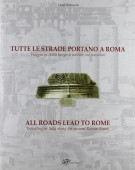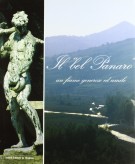Tutte le strade portano a Roma Viaggio in Italia lungo le vie consolari
| Autore/i | Luigi Bernardi | ||
| Editore | Logart Press | Luogo | Roma |
| Anno | 2003 | Pagine | 158 |
| Dimensioni | 24x30x2 (cm) | Illustrazioni | 80 ill. colori n.t. - colors ills |
| Legatura | tela ed. sovracc. ill. colori - hardcover with dustjacket | Conservazione | Usato come nuovo - used like new |
| Lingua | Italiano/Inglese - Italian/English text | Peso | 1800 (gr) |
| ISBN | 8887666091 | EAN-13 | 9788887666090 |
| Prezzo | 45.00 € | Sconto | 40% |
| Prezzo scontato | 27.00 € | ||
Aggiungi al carrello
Edizione speciale edita da Logart press per Banca di Roma.
Traduzione di Madelaine Grimoldi.
Ci sarebbe stata l’Europa – questa che noi oggi conosciamo – senza le strade dei romani? Probabilmente no. Anzi, sicuramente no. Lungo le strade volute da consoli e generali, tracciate da imperatori e custodite da procuratori, sono passate le legioni romane, ma con le legioni è passata la lingua, è passato il diritto, sono transitate forme d’arte, si sono diffusi modelli di vita civile, costumi della civiltà urbana. Questo volume parla, con passione e competenza, delle strade consolari italiane, di quelle strade che hanno reso possibile la prima grande globalizzazione voluta dai romani. “Un legionario seduto è un legionario perduto”. Così soleva dire Ottaviano Augusto Imperatore, al culmine della potenza di Roma: temeva che una volta sgominati gli avversari interni ed esterni, l’improvvisa e inusitata pace infiacchisse gli animi dei soldati conquistatori del mondo. Dalla Penisola Iberica all’Asia Minore, dalla Britannia al Sahara, le aquile romane avevano imposto la pax con la guerra. Ma il riposo non si addiceva ai guerrieri, almeno così la pensava l’Imperatore. Deposte le spade, dovevano mettersi a trasportar pietre e piantarle nel terreno per pavimentare le strade. Saggia decisione. Infatti un efficace sistema di collegamenti era la premessa indispensabile per tenere sotto controllo l’Impero più vasto della storia antica. Per la verità i Romani sapevano da secoli che le strade costituivano una spada e al contempo una mano tesa verso gli altri popoli, perciò si erano preoccupati di costruirne già in epoca repubblicana. Essi vollero in tutto l’Impero strade che durassero aere perennius cioè più del bronzo. E perenni si sono dimostrate, perché su di esse ancora oggi si muovono i popoli moderni.
All roads lead to Rome
Travelling in Italy along the ancient Roman Roads
The best guide to visit Italy in a different and most interesting way! From Southern Italy – Apulia, Naples on to Rome, Florence and the North of Italy, all the way up to Monte Carlo. Travelling in Italy along the old Roman roads built by Consuls and Emperors centuries ago, spreading knowledge, law, language, art, civilization and above all, uniting Italy and Europe. A fascinating itinerary full of historical memories, places where to stop, monuments to see, archaeological sites to visit whilst driving across the oldest, largest and most efficient road network still in use to day. “A sitting legionary is a lost legionary,” as the Emperor Octavian Augustus used to say. He feared that once the internai and external opponents were routed, the sudden and unusual peace would weaken the conquering soldiers worldwide. From the Iberian Peninsula to Asia Minor, from Britannia to the Sahara, the Roman eagles had brought peace with war. The repose did not suit the warriors, at least that is what the Emperor thought. Once the swords were deposed, the soldiers were made to transport stones, place them in the ground and thereby pavé the roads. A wise decision. In fact, an efficient method of road linkage was an indispensable way to control the largest Empire in ancient times. Actually the ancient Romans had known for centuries that roads were both a sword and an outstretched hand to other populations. For this reason, already during the Republican period, roads were built.They wanted roads in the entire Empire that lasted aere perennius, that is longer than bronze. And perennial they have demonstrated to be, because even today they are used by the masses.
Note alle condizioni del volume
Volume nuovo segni del tempo alla sovraccoperta. (T-CA)
Potrebbero interessarti anche...





